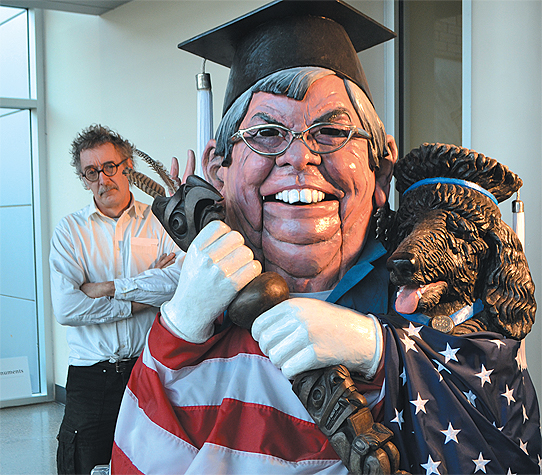
George Rammell with his sculpture Margaux & the Monarch, which includes recovered pieces from Blathering on in Krisendom.
A year after a media storm that shook his campus and his life, George Rammell can at last breathe a sigh of relief. A CAUT investigation into the seizure and destruction of his artwork by the Capilano University administration found his sculpture was an expression of protest and his academic freedom was violated by the seizure.
“They used fear as a strategy to silence me. But when you try to gag someone, it can backfire, and that’s what happened in my case. By destroying my artwork, they provided me with an incredible platform and inspired me to create even more,” Rammell said.
In a scathing report issued this month, a CAUT ad hoc investigatory committee found that Capilano University president Kris Bulcroft and her administration did not support Rammell’s academic freedom, they trampled it. The report calls on the university to publicly apologize and compensate Rammell for the distress caused by the incident.
On May 8, 2014, officials at Capilano seized and dismantled Rammell’s sculpture entitled Blathering on in Krisendom. The satirical piece depicted Capilano’s president with her dog Margaux draped in an American flag. Rammell created the caricature to protest Bulcroft’s role in carrying out controversial cuts to arts courses.
Capilano’s administration argued that placing the sculpture on display on campus was a form of harassment and intimidation, and ran counter to the university’s statement on a respectful work and study environment.
The CAUT report found that Rammell’s sculpture constituted “legitimate political commentary, not bullying or personal harassment,” and concluded the university was “guilty of institutional censorship and violated Rammell’s academic freedom” by seizing his sculpture.
“Academic freedom cannot be undermined merely because an opinion may be shocking. Any university policy limiting freedom of expression more than is permitted by law threatens academic freedom,” wrote the authors in their 14-page report.
“The committee believes that Capilano University was in no way justified in seizing professor Rammell’s work of art. The standard of tolerance applicable to the expression of controversial opinions under academic freedom is much higher.”
But the victory remains bittersweet for Rammell, who enjoyed a 24-year teaching career at Capilano, before the university axed the entire visual arts program last year. He lost his job and his employment insurance benefits are now exhausted.
The former instructor is still passionate about his art and says the incident has inspired him to include pieces of the original in a new, more ornate sculpture entitled Margaux and the Monarch. His artwork is still censured on Capilano’s campus.
“I’m saddened there no longer is a school of visual arts on Vancouver’s North Shore. I deplore the university has decided to turn towards the film industry. They want to tell students what to think rather than show them how to think, and I believe that’s a serious mistake,” Rammell said.